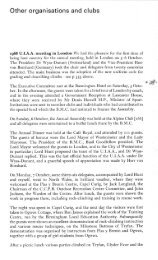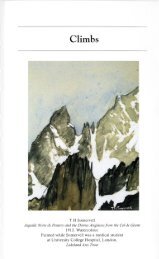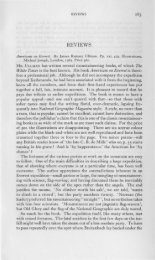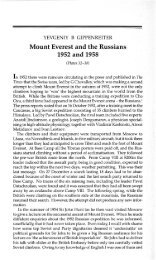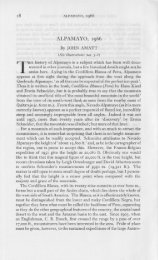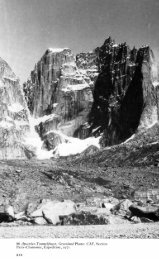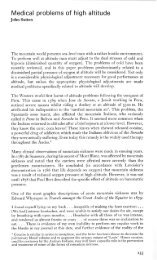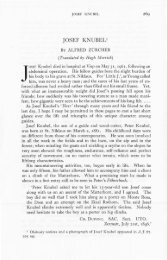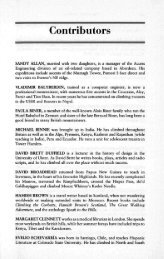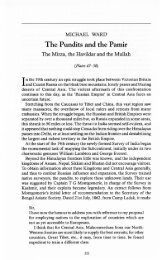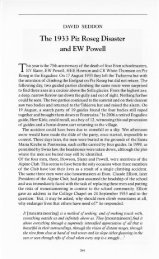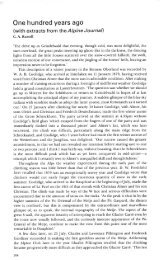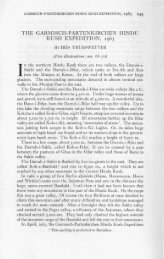The Snow Mountains of Irian Jaya - Alpine Journal
The Snow Mountains of Irian Jaya - Alpine Journal
The Snow Mountains of Irian Jaya - Alpine Journal
You also want an ePaper? Increase the reach of your titles
YUMPU automatically turns print PDFs into web optimized ePapers that Google loves.
THE FIRST ASCENT OF DIBIBOKRI PYRAMID, KULU, 1978<br />
And so our expedition team split up, Mick to England and hospital, we to Nepal<br />
to look at other, bigger mountains. A sad episode, but not a sad ending, as the loss<br />
<strong>of</strong>a toe will not stop him climbing!<br />
Summary<br />
Punjab Himalaya, Kulu, India. Dibibokri Pyramid, 6408m. First ascent 10 October 1978 by<br />
the Dibibokri Col and NW face. Members: Mick H<strong>of</strong>fe, ick Hewitt and Christine Mumford.<br />
Maps<br />
Or Trel11omi's excellent sketch map <strong>of</strong> the Dibibokri Nala is reproduced in the 1970 <strong>Alpine</strong><br />
<strong>Journal</strong>, page 55. A les' useful 'Trekking Map <strong>of</strong> Himachal Pradesh' is produced in 3 sheets by<br />
the Director, West Himalayan Mountaineering Institute, Himachal Pradesh Dept. <strong>of</strong><br />
Tourism, Manali, Distt, Kulu, H.P., India.<br />
<strong>The</strong> <strong>Snow</strong> <strong>Mountains</strong> <strong>of</strong> <strong>Irian</strong> <strong>Jaya</strong><br />
Hilary Collins<br />
'Dingin, Tuan', says Phonis, repeatedly. We know he is cold and feel very sorry and<br />
responsible for him and Ans. We have given them as many <strong>of</strong> our spare clothes as<br />
we dare. <strong>The</strong>re was no way <strong>of</strong> knowing that the Base Camp we were to occupy in<br />
this bleak cwm <strong>of</strong> glacial lakes, with its constant mist and frequent rain, would be<br />
on the main trade route <strong>of</strong> the primitive Dani and Moni tribe. Our Moni porters<br />
refused to leave us completely alone as they were afraid we would lose the gear we<br />
had to leave at Base Camp. <strong>The</strong>y are a wonderful race <strong>of</strong> people, not the savages<br />
some literature would have us believe; but a very respectful people, kind,<br />
thoughtful, and usually happy; but not when it rains!<br />
However after spending 3 weeks trying to find our way into this most unusual<br />
mountain range, the highest between the Andes and the Himalayas, we were<br />
determined to make a small impact on the area. <strong>The</strong> approach march <strong>of</strong>only 5 days<br />
had certainly had its impact on us; neither <strong>of</strong> us had ever felt so scratched, bruised,<br />
or battered in our lives before, as we did after the struggle to keep up with our<br />
running, barefooted, naked porters. For 3 days <strong>of</strong> wet jungle on a track so little<br />
used, that we could not have followed it without our 10 porters as guides, our maps<br />
were totally inadequate. It was almost a sense <strong>of</strong> 'mirage' when we eventually<br />
topped one jungle ridge and saw the <strong>Snow</strong> <strong>Mountains</strong> <strong>of</strong> the Equator hovering in<br />
the far distance before disappearing for another day into clammy clouds.<br />
Reaching Base Camp was a very sobering experience. We found the area around<br />
covered in graffiti and littered with rubbish left by groups who worked at the<br />
American Indonesian Copper Mine. We had tried to approach by the mine but<br />
were actively discouraged, and refused access by the authorities. Our first concern<br />
was to clean up the area to make it a more pleasant 'home', then we set out to<br />
reconnoitre the approach to our proposed first route: the unclimbed S face <strong>of</strong><br />
Carstenz.<br />
On 29 December we were up at first light, having made our 2 Moni guards a<br />
large quantity <strong>of</strong> food for a possible 2 days alone. <strong>The</strong>y could not co-ordinate a<br />
lighter and were therefore incapable <strong>of</strong> lighting a stove, so we had to leave large<br />
quantities <strong>of</strong> food ready cooked as they had no sweet potatoes-their normal<br />
,,8
; <strong>The</strong> CarJlen< glaaerJ In /97 , loo*lIlg IV-CarJltlu PJTam,d (left): II'o//aJlon P* (joregrolllld);<br />
DlIgandoogoo P*J (lowardJ nghLJ: Sgga PIIIII and SlInda)' PJu (<strong>of</strong>f nght! (Pholo: R. MIIgglelon)<br />
diet-left. We were carrying full bivouac gear and a lot <strong>of</strong> hardware, both for ice<br />
and for rock, a wc were n t certain what the proposed route was going IQ be like.<br />
Looking at aerial photOgraphs <strong>of</strong> the 5 race taken in 1972, we knew there were<br />
scveral hanging glacier, and we would therefore need ome i e gear although the<br />
face was not stecp. As it tumed out we did not nced more than our ice axes and<br />
crampons, and a minimum <strong>of</strong> rock gear.<br />
All <strong>of</strong> the glacier in thi area havc retreated for hundred <strong>of</strong> mctre in the la t 6<br />
year. <strong>The</strong>y arc almo t being 'eaten' by a form <strong>of</strong> algae which ha. colonized thi<br />
glacial area. This 'cryovegetation' seem IQ be re pon ible for the formation <strong>of</strong><br />
mall hollow or water on the glacial urface. the ice melting b 'ab orbing radiation<br />
from the un. Although other equatorial glaciers al 0 appear to be retreating, t.hey<br />
do not ha\'e the addilional help <strong>of</strong>thc black algae <strong>of</strong> this al-ea_<br />
To reach the [;lce wc gained the Carsrenz glacier and dropped dm n to the 01<br />
betwecn Carstenl. and \ olla ton Peak, and round to the 5 side along open,<br />
h rizomalledges. A we rea hed what should have been a vantage point from t.he 5,<br />
Ihe clouds descended and tayed \\'ith u , bringing freezing rain for the re t. <strong>of</strong> the<br />
day. nfonunatcly thi also meant that we had no real idea <strong>of</strong> where we were<br />
heading as 1;11' a tlte route \\'a concemed. \. e estimated where we thought the<br />
middle orthe face might be ,lIId went up from there.<br />
In occa ional clearing \\'e saw glacier tongues on eit.her ide <strong>of</strong> u and kept<br />
goin up bet\\'Cen Ihe 2. finding the ea ie t route p ssible bet\\'Cen horizontal trata.<br />
119
THE SNOW MO NTAI S OF IRIAN JAYA<br />
route had probably been created by jusr such regular rainfall as this! IL acted like a<br />
funnel and we were soaked in a few minutes.<br />
We reached the glacier in a white-our and threaded our way along the edge <strong>of</strong> it,<br />
eventually finding a way back to New Zealand Pass. We left all our climbing gear as<br />
high as we could on the pass to collect the next day, and returned to our bivouac<br />
rock.<br />
<strong>The</strong> following day we ascended New Zealand Pass again, picking up our wet and<br />
heavy climbing gear, and descending to Base. To our amazementJean and Bernard,<br />
2 climbers from Marseille, had managed to evade the red-tape <strong>of</strong>entry permits and<br />
had gained access to the interior. So we arranged a 'Franglais' team for our last<br />
roure in tJle area, and rheir first.<br />
As usual the early morning was fine and we were high on the glacier when<br />
white-out conditions arrived to dampen our day. However this easy snow traverse<br />
<strong>of</strong> Sunday Peak and Ngga Palu was very pleasant and constant movement together<br />
kept us much warmer than we had been on the other routes.<br />
'Jalan, jalan'. We were moving away from the mountains and the French team<br />
quickly. <strong>The</strong> ponel"S were happy again and laden with booty from their trading trip<br />
while we were climbing, hurrying us along with their call <strong>of</strong>, 'jalan' (hurry on). <strong>The</strong><br />
jungle journey ahead was medicine more easily taken now we had achieved<br />
something. We enjoyed OUI" Moni men mOI"e and they seemed more trusting <strong>of</strong> us.<br />
For 3 day a minor miracle happened and it did not rain which made the walking so<br />
much more comfortable. Photography <strong>of</strong> the tree ferns, the saprophytes, and the<br />
characters wirh us was very pleasurable. IL seemed thar at last, West <strong>Irian</strong> had<br />
decided to allow us to relax and enjoy it.<br />
Fiction in mountaineering literature 1<br />
George Pokorny<br />
It is remarkable that such an enormous body <strong>of</strong> literature has developed around<br />
one <strong>of</strong> mankind's avocations, mounraineering. It is conceded that much <strong>of</strong> this<br />
writing is concerned with the reporting <strong>of</strong> scientific or explorative accomplishments,<br />
however, a significant amount is devoted strictly to narratives <strong>of</strong><br />
climbing adventures in the mountain. An imponant subdivision <strong>of</strong> this lirerature<br />
<strong>of</strong>the mountains is fiction.<br />
Novelists have utilized many <strong>of</strong> the standard fOI"mulas for plot development in<br />
writing the mountaineering story; that is, adventure, mystery, romance, melodrama,<br />
ete. Because mountaineering is identified as a thrill sport, the reading public expects<br />
a high degree <strong>of</strong> sustained stress and excitement in mountain fiction. While the<br />
adventure thriller is understandably a popular form for the mounraineering novel,<br />
other forms have been u ed successfully. This anicle identifies some rypical<br />
examples <strong>of</strong> the mountaineering novel, and since the number <strong>of</strong> books in this<br />
category is surprisingly large only a small number can be mentioned. Additional<br />
titles are listed in the bibliography at the end <strong>of</strong> this article.<br />
Reproduced from Climbing by kind permission <strong>of</strong> the Editor.<br />
121



